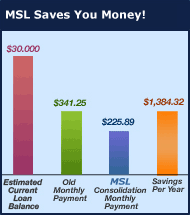How to Minimize Your College Debt
 |
|
||
 |
 |
||
Don't Turn to Loans Immediately
Before you put all of your "eggs" in the "loan basket," consider other options that may get you free money for school!
First Step is the FAFSA
Before you can qualify for any kind of Federal Financial Aid (i.e. grants, federal loans, work study), you have to fill out a Free Application for Federal Student Aid (FAFSA). This application provides the government, as well as colleges, with information that they will use to determine your eligibility for financial aid.
Apply for Grants
Grants are a great deal in that they never have to be repaid. Grants can be obtained through the federal government (such as Pell Grants) or through your school (such as a Supplemental Educational Opportunity Grant "SEOG"). Grants are similar to scholarships, although grants are generally given based on need while scholarships are usually awarded based on merit. The Expected Family Contribution (EFC) information that you provide on the FAFSA will determine whether you are eligible for a federal grant.
Search for Scholarships
There are many scholarships available out there that often go unclaimed because people do not know about them. Not all scholarships are just for those who excel in the classroom. Some scholarships are designed to be awarded to students who are active in their community, have various talents, are of a particular heritage, or something else. Make sure to search for the lesser-known scholarships and apply for as many as you can to increase your chances of being awarded funds for school. Also, use Medical School Loans' Scholarship Search option to find thousands of listings of scholarship information and descriptions.
Take Out Loans
Even if you exercise all of the previous free money options from this article, there is a good chance that you will need some extra money to pay for the high cost of college. If that is the case, student loans can help bridge the gap. Federal and private loans are the options that most students take advantage of because the funds are fairly easy to receive.
Apply for Federal Loans First
From a money-saving standpoint, federal loans are your best bet because they have lower interest rates than private loans. Federal loans are the largest source of educational loans around, and are usually the first choice for borrowers. Federal loans are also backed by the federal government and offer a portion of loans that can be subsidized, whereby the government pays the interest while the borrower is in school or the loans are in deferment.
Put Limits on Your Borrowing
A good way to avoid excessive student loan debt is to put limits on how much debt you are willing to acquire. As with credit cards, mortgages, and many other kinds of debt, student loan lenders are willing to give you a lot more money than you can afford to comfortably repay. And even with today's lower interest rates, interest will start to accrue over time. Add that to an already high loan amount and you may have trouble when it comes time to repay your loans.
Students do face loan limits with federal student loans. But private loans have much higher limits and will typically lend students the difference between the costs of their education and any other financial aid that they may receive. Keep in mind that repayment may seem far off into the future, but it will come a lot sooner than you think.
The key is to borrow the least amount of money that you need to. According to sound financial planning principles, as a student, your student loan payments should not exceed 10% of your expected monthly gross income once you graduate.
Make a detailed list of the costs that are necessary to attend school, and add them up to estimate the minimum amount that you will need to pay. (Do not forget to take into account scholarships, grants, etc.) After you have your list, try your best to not exceed the limit you have set when taking out your student loans.
Start Making Payments Early
If at all possible, try to make small payments on your loans while in school. At the very least, pay on the interest of your loans. This will keep your total debt from growing out of control while you are in school.
Stay on Track
Once you start borrowing, keep track of your debt. It is easy to get confused about how much you owe, particularly if you borrow from a number of different lenders. This will help you to know how much you owe, what your interest rates are at, etc.
Seek Forgiveness
If you do take out student loans, then you should look into forgiveness options that your field of study may offer. Forgiveness programs can compensate part or all of your school loans, depending on the field that you are going into.
These programs are provided by the federal government, state government, military and other various organizations and agencies throughout the country. They offer part or full reimbursement on school loans in exchange for a commitment from recent graduates to work in a field or area pre-determined by the organization. These forgiveness and repayment programs are very similar to scholarship programs. Each organization's criteria, the amount that they offer to pay and the length of time they expect you to commit differs depending on the organization.
Consolidate Your Loans
Once you are out of school, consolidate your federal student loans and/or private student loans. Consolidating your outstanding student loans with a consolidation company like Medical School Loans, will give you just one loan with one low monthly payment, which could save you thousands of dollars over the life of your loans.
Get Help from Uncle Sam
Meet with your CPA to discuss the tax breaks that you can receive for paying on your student loans. You may be able to deduct as much as $2,500 of the annual interest you pay on your loans.
Consider Other Alternatives
If you can not sensibly borrow all of the money that you need to fund your education, then consider the following alternatives.
Go to a College that Wants You to Attend
Your possibilities for an appealing financial aid package will be much higher at a school that is trying to recruit you than at one where you are fighting to get in.
Opt for a Less-Expensive School
Consider starting your education at a two-year community or junior college and then transferring to a four-year university. Depending on the schools, community or junior colleges can cost half as much as universities or state colleges. Or, consider opting for a top-rated public university rather than a mediocre private one.
Get Working
It can be tough to work while attending school. However, working at a part-time job during the school year, a full-time job in the summer, or alternating a semester of work with a semester of study will help keep education expenses down.
Work Study
The Federal Work Study Program helps students with financial need opportunities locate employment opportunities at the college or university where they attend. The student works several hours per week and the money earned is used as a means of financial aid to pay for schooling and the cost of living. Because the money is earned, students participating in this program do not have to pay anything back.
Talk to Your Financial Aid or Guidance Counselor
Obviously there are many methods that you can use to minimize your student loan debt. The examples in this article are not the only options available, so talk to your financial aid or guidance counselor for more ideas.
|
||||||||||||||||||||
+ Consolidate Your Private Student Loans Now! (Save Thousands!!)
Tell A Friend
 |
|
The Healthcare Career Resources column is presented by HealthcareCrossing, America's leading job search site dedicated to getting jobs for healthcare professionals.
Save Money with a Private Student Loan Consolidation from Medical School Loans By Brooke Heath Even as a young child practicing medicine on your stuffed animals, you knew that you were destined to become a physician. But the road to obtaining your medical degree takes more than just the ability to mend the imaginary wounds of a teddy bear. + read more |


| CALCULATORS | |
| Stafford Loan Payment Calculator | |
| PLUS Loan Payment Calculator | |
| Loan Consolidation Payment Calculator | |




